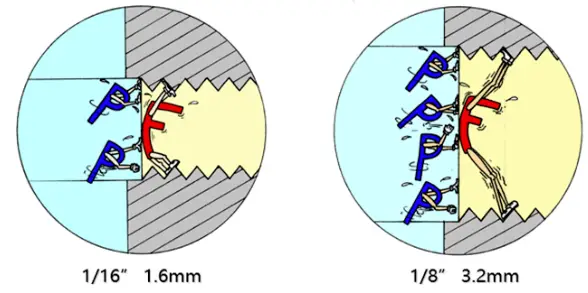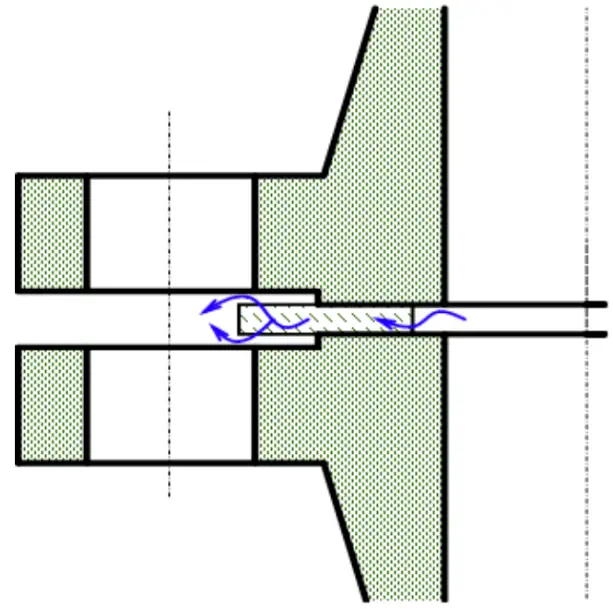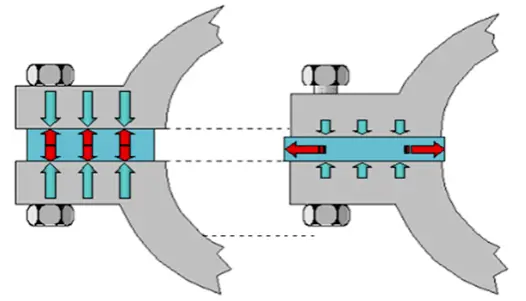Guidance on gasket thickness for non-metallic flat washers is missing from ASME B16.21. Selecting the appropriate gasket thickness for a specific application is a recurring problem and difficult to answer succinctly.
Therefore, we encourage users, when in doubt about thickness selection, to consult application engineers.
Today's article aims to elucidate why this problem is complex, while also imparting relevant application knowledge to prepare users for potential scenarios.
As gasket application engineers, we generally advocate using thinner gaskets whenever possible.
In certain situations, however, a thicker gasket is advisable.
We will clarify this: a 3.2 mm thick gasket is required and completely acceptable for some common operating conditions, including the following:
- Thin flanges will be uneven after tightening the screws, such as 6.4mm thick angle iron or steel plate flanges.
- Large diameter flanges, such as those complying with the AWWA (American Water Works Association) standard, and pressure vessels 3 meters in diameter.
- Low pressure, full face, large diameter flanges with limited bolt force.
- Older flanges that may have some degree of corrosion, warping or damage.
One of the reasons why thick gaskets are used for low-pressure, large-diameter flanges is that these flanges do not have enough bolts, mainly because the internal pressure is low, so many bolts are not required in the design.
Limited bolts mean limited compression of the joint; Thin flanges imply that the flange will deform after the bolts are tightened, compressing the gaps between the bolts to a minimum level or not at all. Thin gaskets do not have enough compression to compensate for these uneven flanges.
This seems to contradict our usual thinking. If you look at our recommended installation tension, we will require greater tension (load) with an increase in joint thickness.
However, in locations where the load is very low, such as angle iron flanges, there is often not enough flange thickness to provide the flatness and sealing required for thin joints.
In most cases, these flanges have low internal pressure, so there is no high risk of explosion for thicker gaskets.
For example, let's consider a box of 66 flanges: the flange thickness is approximately 6.4 mm, with 20 5/8 screws. For such a large flange, the number and size of screws are insufficient.
The customer asked about a 1.6mm oil-water self-expanding gasket for non-pressure oil, but a better choice would be a 3.2mm thick gasket for two reasons:
- Such a large spacing between bolts results in very small compression loads between two bolts. Thin gaskets do not adapt well to warped flanges.
- Without internal pressure, using a thicker gasket has no disadvantages or inconveniences as the gasket will not burst.
However, for flanges designed for higher pressures, the situation differs significantly. These flanges are much thicker, which typically allows them to maintain flatness, achieving 0.1mm flatness when the screws are tightened.
In these cases, the thinner approach is more appropriate.
There are numerous advantages to using thin gaskets:
(1) Greater explosion resistance due to smaller area exposed to internal pressure.

(2) Reduced leakage rate, also due to the smaller area in contact with the internal pressure.

(3) Better torque retention in fasteners due to the lower creep relaxation properties of thinner joints.

(4) Lower cost due to less material usage.
Although the thinner the joint the better “as far as possible”, this principle is the most difficult to define; using thin joints is not always possible.
Thicker gaskets are more suitable for severely damaged or warped flanges. The ability of a gasket to fill irregular flanges is based on the amount of compression under a given load. This compression ratio is expressed as a percentage of the original gasket thickness.
Thicker gaskets, with a greater original thickness, also have a greater actual amount of compression. For a 1.6mm gasket, a compression ratio of 10% means a compression amount of 0.16mm, while a 3.2mm gasket compressed at 10% has a compression amount of 0.32mm.
This additional compression of the gasket means that thick gaskets can fill deep scratches or holes better than thin gaskets.
However, the advantages of using a thick gasket can be misleading. Regardless, when thicker gaskets are used to seal more defective flanges, they can cause more problems in the future.
Thicker gaskets result in greater creep relaxation, which means that throughout the life of the flange connection, users may need to retighten bolts to maintain sufficient compression of the gasket.
Thicker gaskets can also lead to greater bursting force, compounded by an increased area in contact with internal pressure, which generates a greater total force trying to push the gasket away from the flange (rupture force).
(The unit for internal pressure is MPa, and a thicker joint appears “taller” in the direction facing internal pressure, which means a greater surface area. The greater force results from the MPa internal pressure multiplied by the greater area.)
Lastly, as all gasket materials are somewhat permeable, media can penetrate the gasket body. Thicker gaskets create larger permeation channels, resulting in a higher leak rate.
Note that the reverse can also occur. If a gasket is too thin to compensate for flaws in the flange, media will leak instead of through the gasket body, and the leak rate may be greater than with a thick gasket.
Flanges that require thicker gaskets can cause problems that gasket manufacturers cannot control.
The best solution is to use or design flanges that can provide a greater compression load, maintain a good condition of the flange surface, and use gaskets with a thickness of 1.6 mm or even 0.8 mm.
When designing to use non-asbestos sheet gaskets, users should consider using higher thickness “M&Y” values of 3.2mm in their design calculations, but install a 1.6mm thick gasket. These recommendations will eliminate some of the most common causes of flange connection failures.
In special cases, washers with very specific thicknesses are required. There are numerous washer connections that require a specific washer thickness. For these types of connections, it is essential to remember that the final compressed thickness of the washer must be taken into account. This may include the following scenarios:
Split Pumps: Final thickness is critical as it affects the clearance between both sides of the pump. These pumps typically use 0.4mm non-asbestos compression washers.
Sometimes customers require metal sheets with small thickness tolerance and minimum thickness variation. It is important to remember that washers with high compression are generally not applicable here, as the final thickness is different.
Long distance piping systems designed for specific washer thicknesses. For example, a standard spiral washer, when compressed, measures approximately 3.2 mm thick. There may be a spacing problem on long-distance pipelines if thinner washers are used, and there are numerous flanges on a single pipeline, creating a large gap at the last flange.
Washers used in grooves: When using tongue-and-groove surfaces or concave flat flanges, the washer must fill the entire space before the flange metal comes into contact with other metal. The compressed thickness of the loaded washer must be calculated and must exceed the gap created after flange contact.
For example, if the groove is 3.2mm deep, the tongue is 0.6mm high, the compressed thickness of the washer must exceed 2.6mm, otherwise the flanges will come into contact before the washer is fully compressed.
The type of washer material and the allowable compression load can also affect the thickness of the washer that seals a specific flange connection. According to the ASTM F36 standard test, washers with a higher compression ratio do not require the same thickness as those with a lower compression ratio, as a more easily compressed washer does not need to be as thick to accommodate flange defects.
We are always asked to seal defective flanges. This can usually be achieved by carefully considering all variables of application conditions when choosing washer material type and thickness.
However, sometimes the defects of the flange or bolt are not fully compensated by the washer. Likewise, proper installation of the flanged connection system is also crucial.

























































